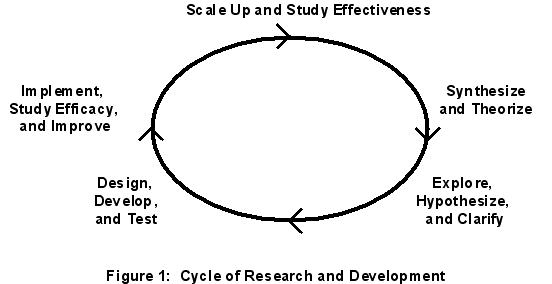Accounting for Research and Development Activity
In general, research and development (R&D) activities are conducted by specialized units or centers belonging to a company, or can be outsourced to contract research organizations, universities, or state agencies . In the context of commerce, research and development normally refers to future-oriented, long-term activities in science or technology, using similar techniques to scientific research but directed toward desired outcomes and with broad forecasts of commercial yield.

Cycle of Research and Development
Cycle of Research and Development, from "Research and Evaluation on Education in Science and Engineering (REESE), Program Solicitation NSF 09-601"
In the United States, a typical ratio of research and development for an industrial company is about 3.5% of revenues. A high technology company such as a computer manufacturer might spend 7%. Although Allergan (a biotech company) tops the spending table with 43.4% investment, anything over 15% is remarkable and usually gains a reputation for being a high technology company. Companies in this category include pharmaceutical companies such as Merck & Co. (14.1%) or Novartis (15.1%), and engineering companies like Ericsson (24.9%). Such companies are often seen as credit risks because their spending ratios are so unusual.
Research and development costs are the costs incurred in a planned search for new knowledge and in translating such knowledge into new products or processes. Prior to 1975, businesses often capitalized research and development costs as intangible assets when future benefits were expected from their incurrence. Due to the difficulty of determining the costs applicable to future benefits, many companies expensed all such costs as incurred. Other companies capitalized those costs that related to proven products and expensed the rest as incurred.
As a result of these varied accounting practices, in 1974 the Financial Accounting Standards Board in Statement No. 2 ruled that firms must expense all research and development costs when incurred, unless they were directly reimbursable by government agencies and others. Immediate expensing is justified on the following grounds:
- The amount of costs applicable to the future cannot be measured with any high degree of precision
- Doubt exists as to whether any future benefits will be received
- Even if benefits are expected, they cannot be measured
Research and development costs thus no longer appear as intangible assets on the balance sheet. The Board applies the same line of reasoning to other costs associated with internally generated intangible assets, such as the internal costs of developing a patent.
R&D As an Administrative cost
Administrative costs are non-manufacturing costs that include the costs of top administrative functions and various staff departments such as accounting, data processing, and personnel. Executive salaries, clerical salaries, office expenses, office rent, donations, research and development costs, and legal costs are also administrative costs. As with selling costs, all organizations have administrative costs.